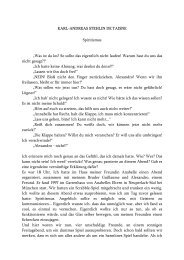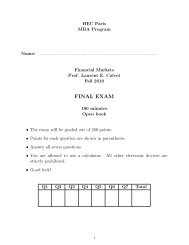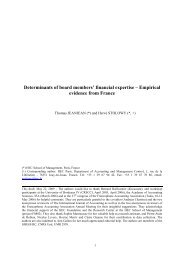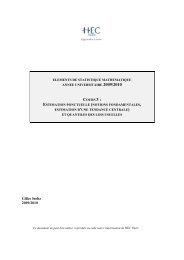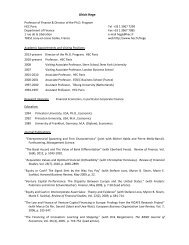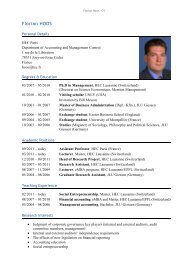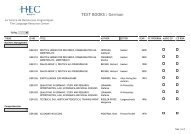Multifractality of US Dollar/Deutsche Mark Exchange Rates - Studies2
Multifractality of US Dollar/Deutsche Mark Exchange Rates - Studies2
Multifractality of US Dollar/Deutsche Mark Exchange Rates - Studies2
Create successful ePaper yourself
Turn your PDF publications into a flip-book with our unique Google optimized e-Paper software.
with the MMAR (Figure 15). Moments up to q = 5 appear in 19a. Moments around q = 2 appear<br />
in 19b.<br />
The high moments are irregular, and many show a tendency towards concavity. The partition<br />
functions for the MMAR, in contrast, are mostly straight. Some partition functions for FIGARCH<br />
approximately follow the best fit line <strong>of</strong> the data, although not as convincingly as MMAR partition<br />
functions. A reasonable degree <strong>of</strong> ambiguity suggests that developing stronger inference methods<br />
will be important in the future.<br />
A more clear distinction exists in low moments. The MMAR partition functions around q =2<br />
follow predicted values very closely, while almost half <strong>of</strong> FIGARCH partition functions are quite<br />
irregular. Of the remaining partition functions, most are closer to the predictions for Brownian<br />
Motion than best fit lines <strong>of</strong> the DM/<strong>US</strong>D data.<br />
This section investigated scaling properties <strong>of</strong> simulated GARCH and FIGARCH processes.<br />
Neither process appears as likely as the MMAR to scale like the DM/<strong>US</strong>D data. Barring theoretical<br />
results that allow distributional inference, more systematic simulation evidence is needed.<br />
7 Robustness Tests<br />
7.1 Alternative Reporting Methods<br />
This section tests sensitivity <strong>of</strong> results to alternative reporting methods for the data, including<br />
price approximation by bid or ask or average, and source <strong>of</strong> data. We obtained daily data from<br />
the Federal Reserve Bank <strong>of</strong> New York covering approximately the same sample span as the Olsen<br />
daily data. The Fed data is recorded at noon in New York, and is a buying rate for foreign<br />
currencies. Because <strong>of</strong> missing data, two separate data sets were constructed. FED1 supplements<br />
missing values with Olsen data. FED2 eliminates missing observations. Appendix 9.3 provides<br />
more information on construction.<br />
Figure 22 shows partition functions for FED1 and FED2. Figure 23 compares the multifractal<br />
spectra <strong>of</strong> these series with the previously estimated spectrum <strong>of</strong> Olsen data. Results are not sub-<br />
stantially affected by the use <strong>of</strong> these alternative data sets. Thus, reasonable variations, including<br />
treatment <strong>of</strong> missing values, use <strong>of</strong> bid or ask or an average, and use <strong>of</strong> price quotes or government<br />
reported rates, do not seem to substantially alter results. 39<br />
39 Although the two daily spectra are quite similar, the Fed spectra are narrower. This might be expected based<br />
28



